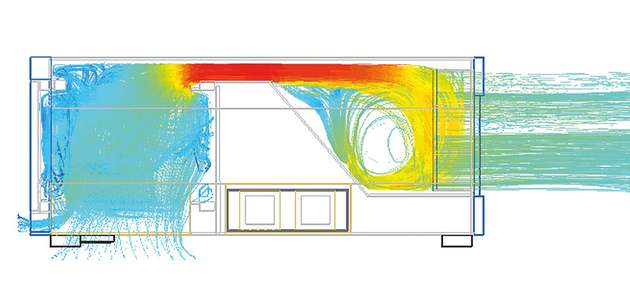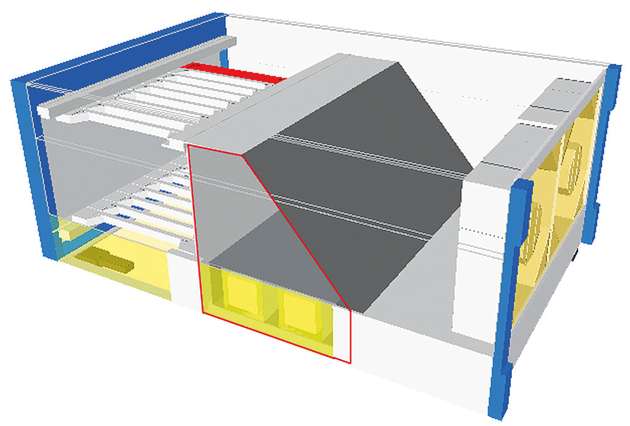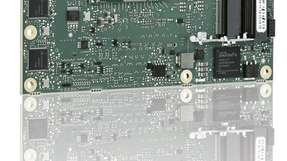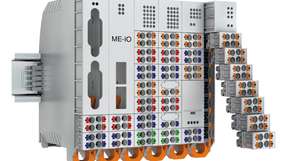PXI/PXIe is an ideal deployment platform for measurement and automated test systems, environments in which reliability is critical. In the development of a reliable PXI/PXIe platform, however, thermal issues demand maximum consideration. Priorities include: ensuring that airflow is sustained when passing over elements in need of cooling; minimizing the take-in of unwanted additional heat; successfully balancing maximization of exhaust port dimensions with safety considerations; and optimizing the PQ curve of fan placement. Of equal concern is power supply disposition. Providing a dedicated heat dissipation path for the power supply enables an optimum thermal solution.
Effective PXI/PXIe chassis design must take into consideration aspects of module deployment that can affect airflow. PXI/PXIe chassis generally provide 3U PXI modules for 4U chassis. In this confined space, thermal management and sustained reliability present significant challenges.
Positioning & Configuration
Fans are frequently deployed in PXI/PXIe chassis on the bottom of the chassis interior. However, such a configuration has a tendency to impede or interrupt airflow, adversely affecting overall cooling efficiency. For example, connection slots between a pair of fans can easily experience higher temperatures than do connection slots in other locations due to uneven airflow. This presents a challenge in the planning and configuration of the system. Thus, disposition of the fan at the rear of the chassis can improve airflow integrity.
Irrespective of location, airflow can normally be generated by fan outflow or fan intake, based on the direction of rotation. If outflow is employed, airflow velocity is increased. But control of the airflow's path can be difficult, and, according to PXI specifications, airflow must pass the module from bottom to top such that heat is dissipated through top vents, potentially compromising critical environments. If fan intake is employed, airflow velocity is lower, but airflow is steadier and more easily controlled.
The airflow pathway must also be considered in fan configuration. Avoiding additional sources of heat and effectively exhausting cool air are major considerations for chassis design. Many users adopt hybrid test systems, installing their PXI/PXIe systems in a system rack cabinet. In this case, potential heat sources across the entire hybrid test system demand attention, not just the PXI/PXIe system itself.
When fans positioned in the rear of the PXI/PXIe chassis draw air in from the exterior and then exhaust it through the front of the chassis, the possibility exists for air heated by neighboring systems to be drawn in and forced over the PXI/PXIe modules, thereby creating an obvious disadvantage in the cooling of the overall system. Newer PXI/PXIe chassis designs use rear-mounted fan designs that channel unheated air from the front through the PXI modules, into the back of the chassis, and then out of the system, thereby maintaining intended levels of dissipation efficiency.
Optimal Vent Design
To effectively guide airflow and obtain optimal cooling results, the disposition of chassis vents is critical. Balancing safety requirements and structural limitations can present significant design challenges. Placement of vents is restricted to actual air intake/exhaust locations in compliance with PXI specifications, and height is limited by the bottom line of installed PXI modules. Misplacement is likely to impair airflow at the two rear sides. As a result, the new PXI/PXIe chassis designs not only provide vents in corresponding locations on the front and back, but further enhance dissipative efficiency with maximized apertures on both the sides and front panel.
Inherent environmental restrictions on PXI/PXIe chassis require precise calculations to be made to achieve optimal configuration for PQ curve and airflow quality. Ideally, flatter paths over longer distances provide maximum fan performance. Space restrictions, however, require extensive simulation trials to determine the optimum slope of the backplane baffle.
Power Supply Module Configuration
Selection and configuration of a power supply can be equally challenging. Often overlooked is the fact that the power supply itself also produces heat, potentially affecting PXI/PXIe chassis performance.
Most conventional designs fail to
separate flow of heat dissipated from the power supply from that of the chassis itself. Also, forceful ventilation from the power supply can frequently produce a chaotic airflow condition within the chassis. Accordingly, separation of heated airflow from the respective elements is critical, with independent vents and fans for the power supply contributing considerably to improved overall
cooling.
Conclusion
PXI/PXIe chassis design must not only take into consideration design of the machine chassis itself, but also the inclusion of other measurement systems in common working environments. Design aspects to consider include fan configuration, airflow planning, selection of power supplies, and modular performance optimization, to name a few.
Fortunately, today's PXI/PXIe-based systems are being designed from spec-out to build-out to directly address these and other system demands, presenting a definitively reliable platform for mission-critical applications.


















